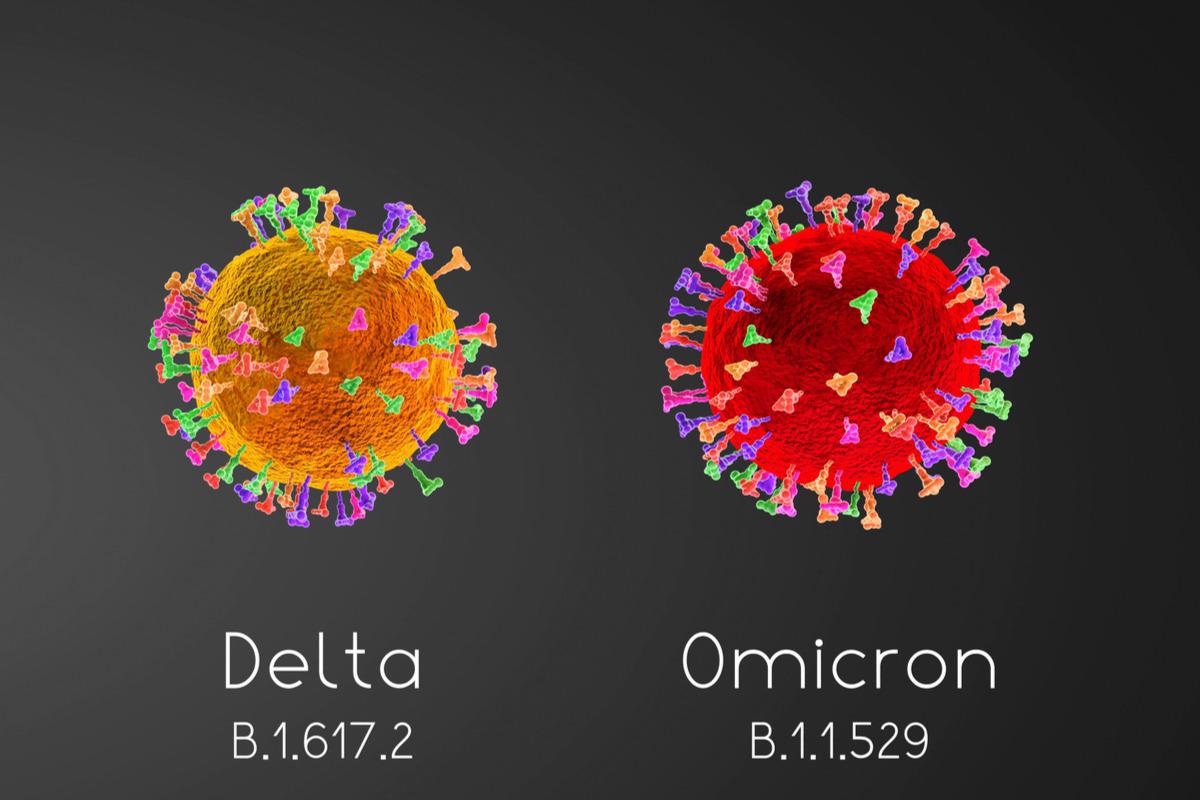In a recent study posted to the medRxiv* preprint server, researchers from the United Kingdom (UK), performed an epidemiological cohort study to assess differences in transmission of the severe acute respiratory syndrome coronavirus 2 (SARS-CoV-2) Omicron and Delta variants in England.
 Study: Comparative transmission of SARS-CoV-2 Omicron (B.1.1.529) and Delta (B.1.617.2) variants and the impact of vaccination: national cohort study, England. Image Credit: PX Media/Shutterstock
Study: Comparative transmission of SARS-CoV-2 Omicron (B.1.1.529) and Delta (B.1.617.2) variants and the impact of vaccination: national cohort study, England. Image Credit: PX Media/Shutterstock
In England, the SARS-CoV-2 Omicron variant (B.1.1.529) became dominant and rapidly replaced the Delta variant (B.1.617.2) in January 2022. Studies have revealed that as compared to other SARS-CoV-2 variants, the Omicron variant is related to increased transmissibility and reduced vaccine effectiveness.
In the current study, the researchers used secondary attack rates and household clustering for assessing the transmissibility of the Omicron and Delta variants at the time when both variants were circulating in England.
Study design
The current study was performed between 5 and 11 December 2021, in England when both the Omicron and Delta were co-circulating. SARS-CoV-2 positive results were reported by National Health Service (NHS) laboratories to the UK Health Security Agency (UKHSA). Lab reports with lateral flow device (LFD) testing data were stored in the second generation surveillance system (SGSS) of UKHSA.
Omicron and Delta variants were defined by genomic sequencing and genotyping of confirmed polymerase chain reaction (PCR) cases and through S-gene target failure (SGTF). Genomic sequencing in England was held in the cloud infrastructure for big data microbial bioinformatics database (CLIMB) and coordinated by the coronavirus disease 2019 (COVID-19) Genomics, UK (COGUK).
Vaccination data for COVID-19 in England was retrieved from the National Immunisation Management System (NIMS). SARS-CoV-2-positive individuals’ data were sent for contact tracing with nationally collated data (NHS test and trace records) and the assessment of transmission to named contacts was performed using this data. Two or more SARS-CoV-2-positive cases at the same residential dwelling with identical unique property reference numbers (UPRN) were defined as household clusters.
Findings
During the study, the researchers observed a mean of 2.0 contacts per case for the Delta variant and 1.7 for the Omicron variant, out of which 1.6 and 1.1 were household contacts and 0.4 and 0.6 non-household contacts for Delta and Omicron, respectively. When exposure was inside and outside the household, the serial median interval to a secondary case was four days and three days for Delta and Omicron, respectively.
The cycle threshold (CT) values were ≤ 30 days for a nucleocapsid and open reading frame (ORF) 1ab gene in Delta cases (98.7%), and Omicron cases (99.2%). Among named household contacts, the unadjusted secondary attack rate for Omicron and Delta was 15.0% and 10.8%, respectively, while in non-household contact it was 8.2% and 3.7%, respectively.
The team noted that for Omicron cases, the ratio of overall transmission risk to household contact was 1.48 and for non-household contacts 2.14 as compared to the Delta cases. In non-household settings, for exposed contacts to Delta who have received three doses of vaccines, the secondary attack rates were 3.0% as compared to 5.1% in non-vaccinated contacts. Similarly in household settings, it was 7.6% compared to 12.9%, respectively.
When the number of the vaccination dose was reduced from three to no dose, the transmission in non-household settings was 3.1% vs 4.9%, respectively, while in household settings it was 6.2% vs 11.8%, respectively. Similarly adjusted ratio risk of transmission in non-household cases who had received the third dose of vaccine was 0.51 compared to two doses, while for household contact the ratio was 0.68.
The team analyzed that in household settings, individuals who have received three doses showed a protective adjusted risk ratio in contacts (0.88) or exposers (0.78) compared to two doses. While in non-household contacts, it was 0.76 while no differences in exposers were observed.
The researchers showed that, in unvaccinated household contacts of unvaccinated Omicron cases, the secondary attack rate was 16.2% compared to 14.6% in unvaccinated Delta cases with a 1.11 adjusted risk ratio. While in non-household contacts, it was 11.6% for unvaccinated Omicron cases and 6.3% for unvaccinated Delta cases with an adjusted risk ratio of 1.84.
The team observed that the risk of household transmission was lower in all other age groups particularly children as compared to contacts aged 30-39 years (except 40-49 years old), males (compared to female contacts), and exposers under age 30 (compared to 30-79 years old exposers). In non-household contacts exposers. under 20 years of age were at less risk of transmission than 30-69 years olds.
As compared to the East Midlands (reference region), non-household contacts of exposers in London were more probable to become cases while North West household contacts were less probable to become cases. The researchers observed that among the reported 13.5% Delta and 8.8% of Omicron asymptomatic cases in households exposures, half of the cases had the probability [adjusted odds ratio (aOR) 0.47 (0.44-0.51)] for transmission to their household contacts compared to symptomatic cases.
For Omicron variants, the overall risk ratio of household clustering was 3.54 compared to the Delta variants. Furthermore, as per the vaccination status, specifically in the index cases that were ≥14 days after the third dose of vaccine, there was an increased risk of household clustering in the Omicron variant compared to the Delta. Additionally, the team observed that younger cases index cases (<30 years age) and Black ethnic group had a lower probability of household clustering as compared to >40 years age and the White ethnic group, respectively.
In the restricted model, including individuals with travel history outside the UK, there was an overall adjusted odds ratio for household clustering of 4.53 for Omicron index cases compared to 4.51 in Delta while no significant change was noticed in the model excluding cases with travel history outside the UK.
Conclusion
The findings of this study demonstrated a high transmission risk from the SARS-CoV-2 Omicron variant as compared to the Delta variant in both household and non-household settings. It also showed the significant attenuation of the protective effect of COVID-19 booster vaccinations in reducing onwards transmission from Omicron cases, as compared to the Delta variant.
The study highlighted the need for genomic surveillance to identify and understand the impact of newly emerging SARS-CoV-2 variants on hospitalization, disease incidents, and deaths and to accelerate public health interventions like the roll-out of the booster vaccination for these emerging variants.
*Important notice
medRxiv publishes preliminary scientific reports that are not peer-reviewed and, therefore, should not be regarded as conclusive, guide clinical practice/health-related behavior, or treated as established information.
- Hester Allen, et al. (2022).Comparative transmission of SARS-CoV-2 Omicron (B.1.1.529) and Delta (B.1.617.2) variants and the impact of vaccination: national cohort study, England. medRxiv. doi: https://doi.org/10.1101/2022.02.15.22271001 https://www.medrxiv.org/content/10.1101/2022.02.15.22271001v1
Posted in: Medical Research News | Medical Condition News | Disease/Infection News
Tags: Bioinformatics, Children, Coronavirus, Coronavirus Disease COVID-19, covid-19, CT, Gene, Genomic, Genomic Sequencing, Genomics, Genotyping, Omicron, Polymerase, Polymerase Chain Reaction, Public Health, Respiratory, SARS, SARS-CoV-2, Severe Acute Respiratory, Severe Acute Respiratory Syndrome, Syndrome, Vaccine

Written by
Sangeeta Paul
Sangeeta Paul is a researcher and medical writer based in Gurugram, India. Her academic background is in Pharmacy; she has a Bachelor’s in Pharmacy, a Master’s in Pharmacy (Pharmacology), and Ph.D. in Pharmacology from Banasthali Vidyapith, Rajasthan, India. She also holds a post-graduate diploma in Drug regulatory affairs from Jamia Hamdard, New Delhi, and a post-graduate diploma in Intellectual Property Rights, IGNOU, India.
Source: Read Full Article